Abstract
Background
We recently identified a novel mutation in large family characterised by premature nocturnal sudden death. In the present paper we provide an overview of the findings in this family.
Methods
From 1958 onwards, when the first patient presented, we collected clinical data on as many family members as possible. After identification in 1998 of the underlying genetic disorder (SCN5A, 1795insD), genotyping was performed diagnostically.
Results
Since 1905 unexplained sudden death occurred in 26 family members, 17 of whom died during the night. Besides sudden death, symptomatology was rather limited; only six patients reported syncopal attacks. In one of them, a 13-year-old boy, asystolic episodes up to nine seconds were documented. Until now, the mutation has been found in 114 family members (57 males, 57 females). Carriers of the mutant gene exhibited bradycardia-dependent QT-prolongation, intrinsic sinus node dysfunction, generalised conduction abnormalities, a paucity of ventricular ectopy, and the Brugada sign. Cardiomyopathy or other structural abnormalities were not found in any of the carriers. Electrophysiological studies showed that mutant channels were characterised by markedly reduced INa amplitude, a positive shift of voltage-dependence of activation and a substantial negative shift of voltage-dependence of inactivation of INa. From 1978 onwards, a pacemaker for anti-brady pacing was implanted for prevention of sudden death. In patients in whom a prophylactic pacemaker was implanted no unexplained sudden death occurred, whereas 5 sudden deaths occurred in the group of patients who did not receive a pacemaker.
Conclusion
We have described a large family with a SCN5A-linked disorder (1795insD) with features of LQT3, Brugada syndrome and familial conduction system disease. Anti-brady pacing was successful in preventing sudden death. The mode of death is possibly bradycardic.
Keywords: sudden death, long-QT syndrome, Brugada syndrome, SCN5A, pacemaker
Full text
PDF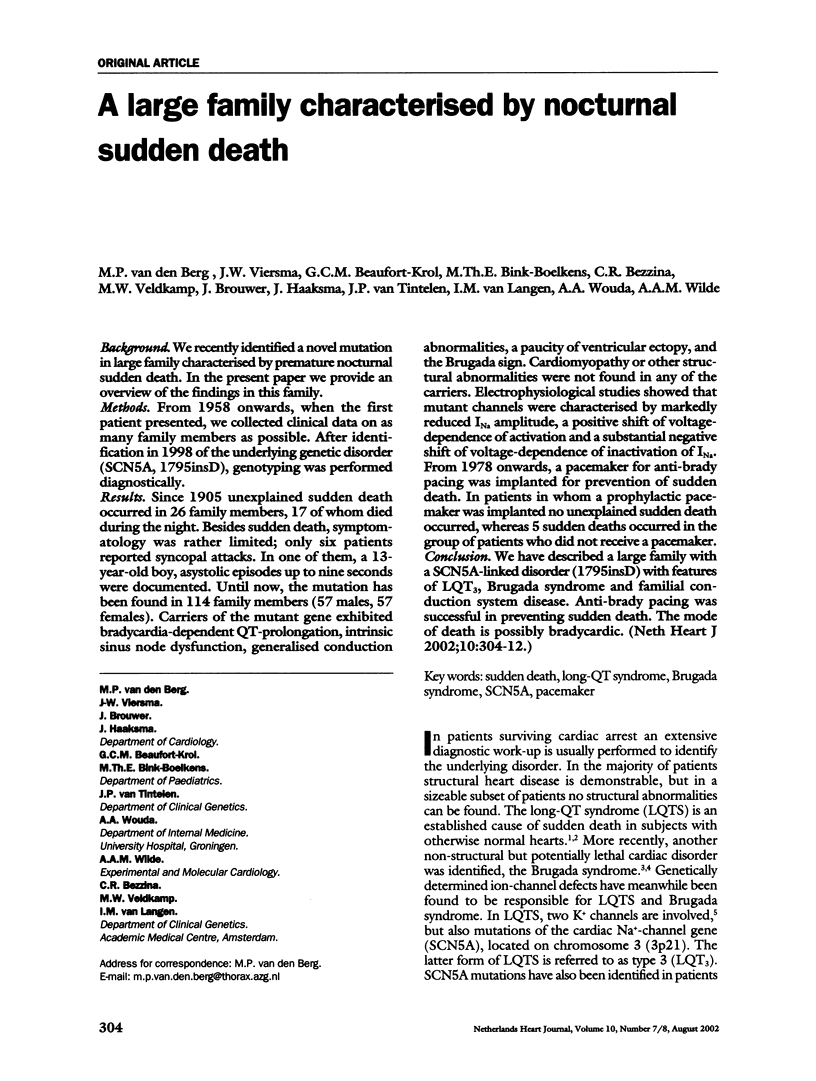
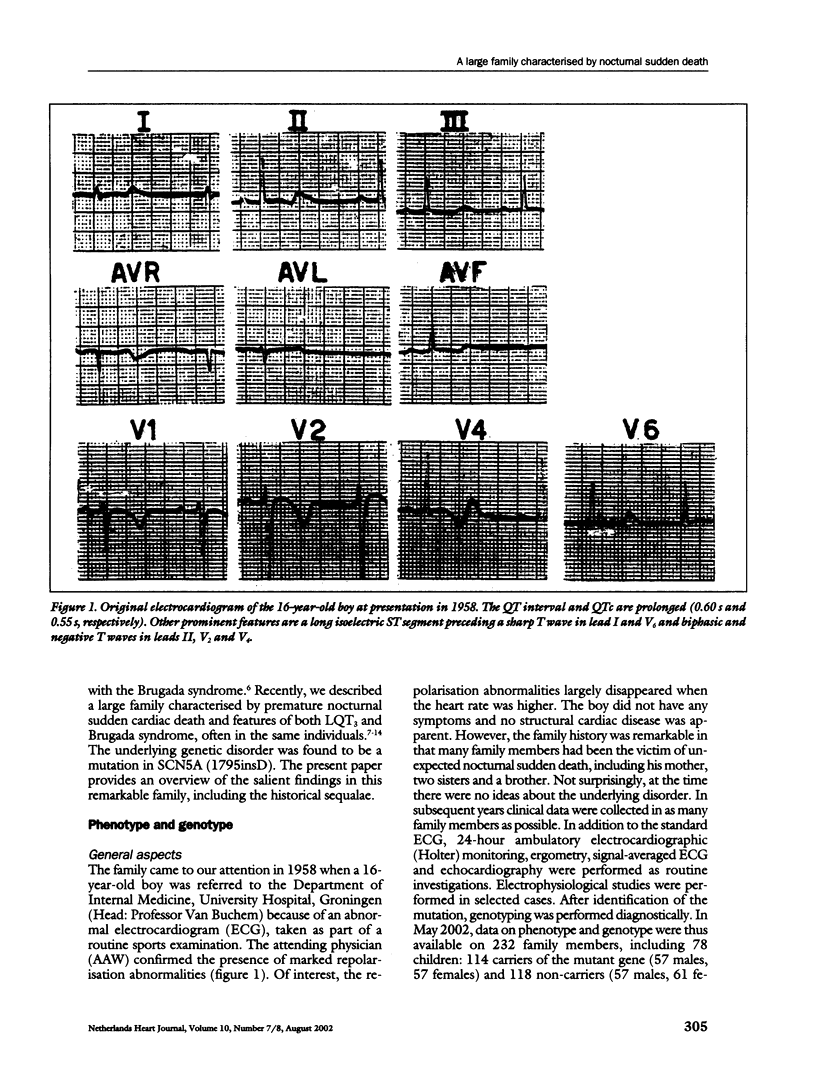
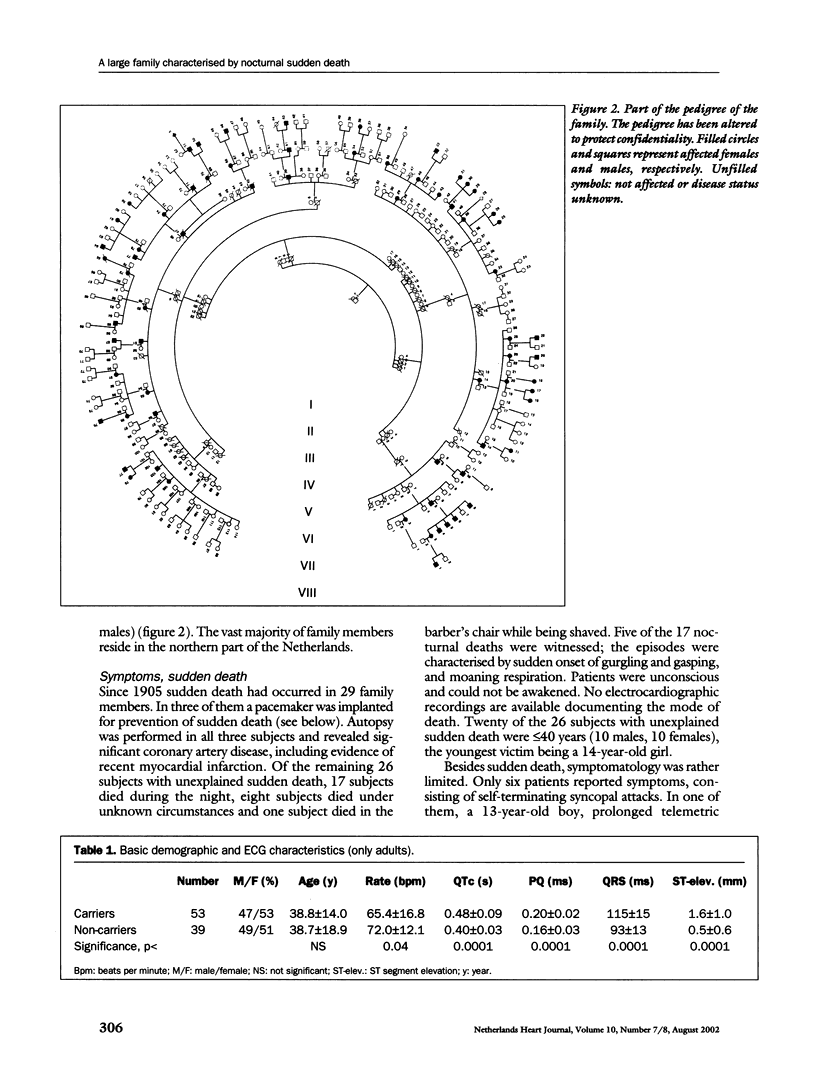
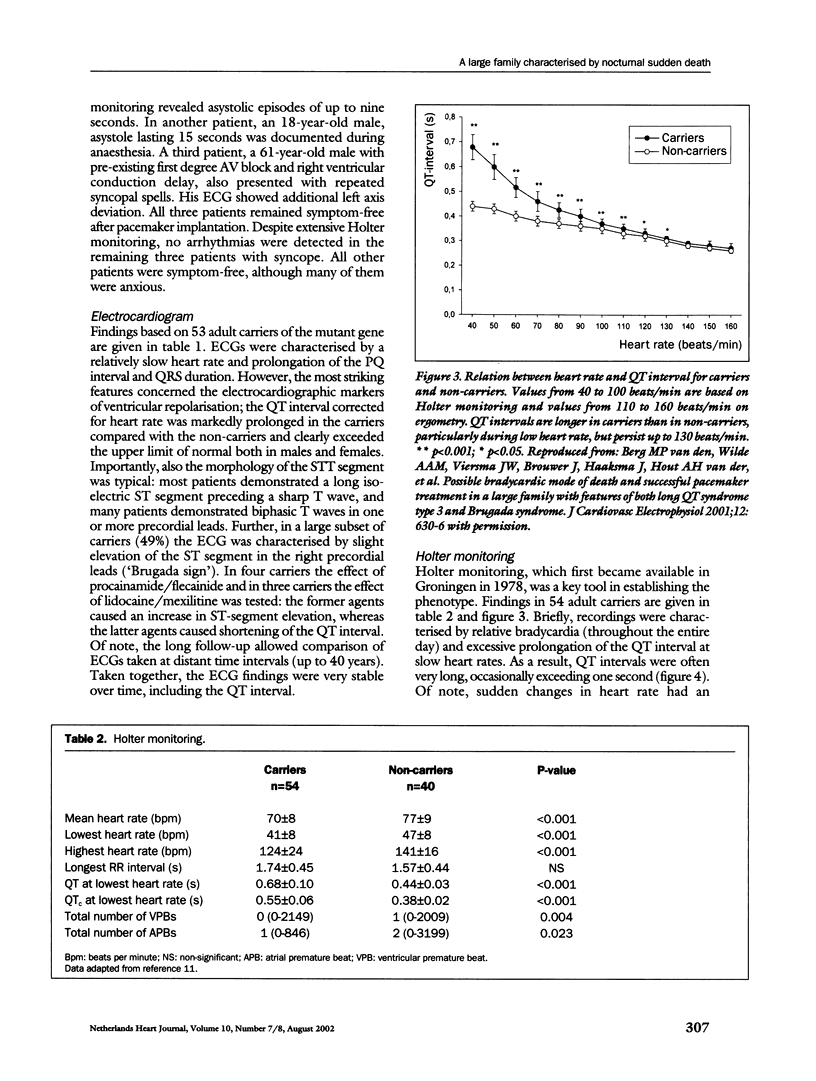
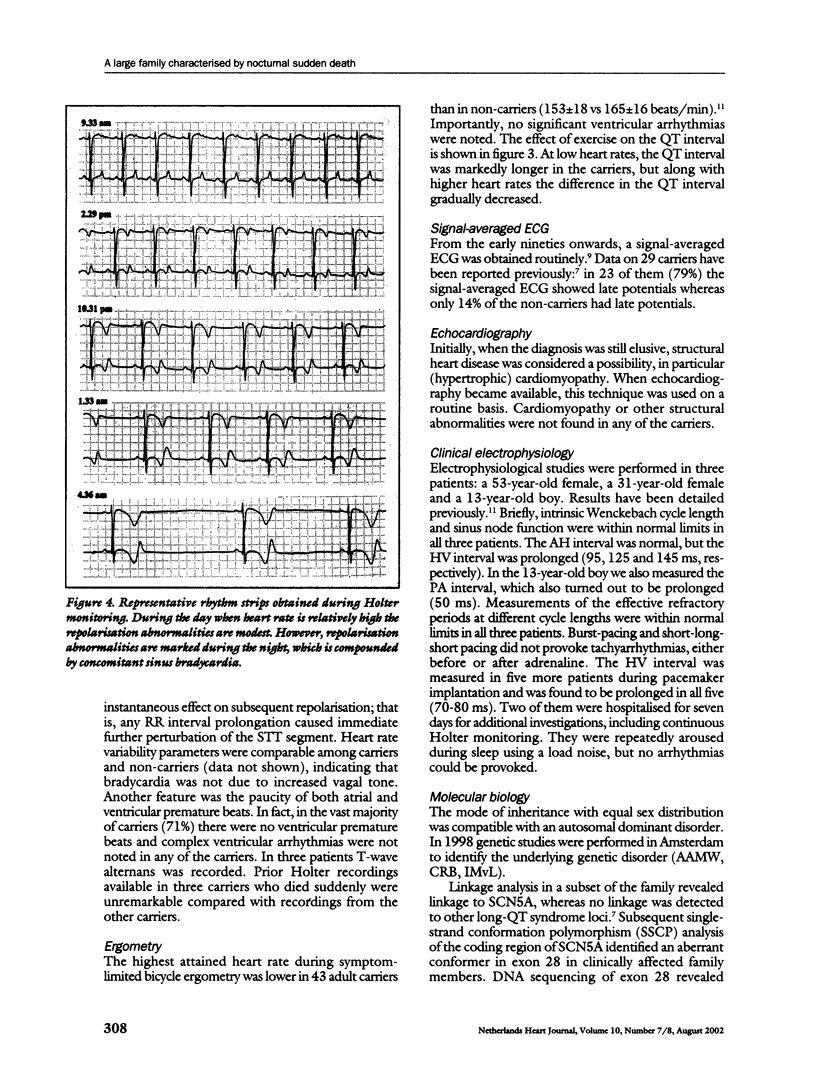
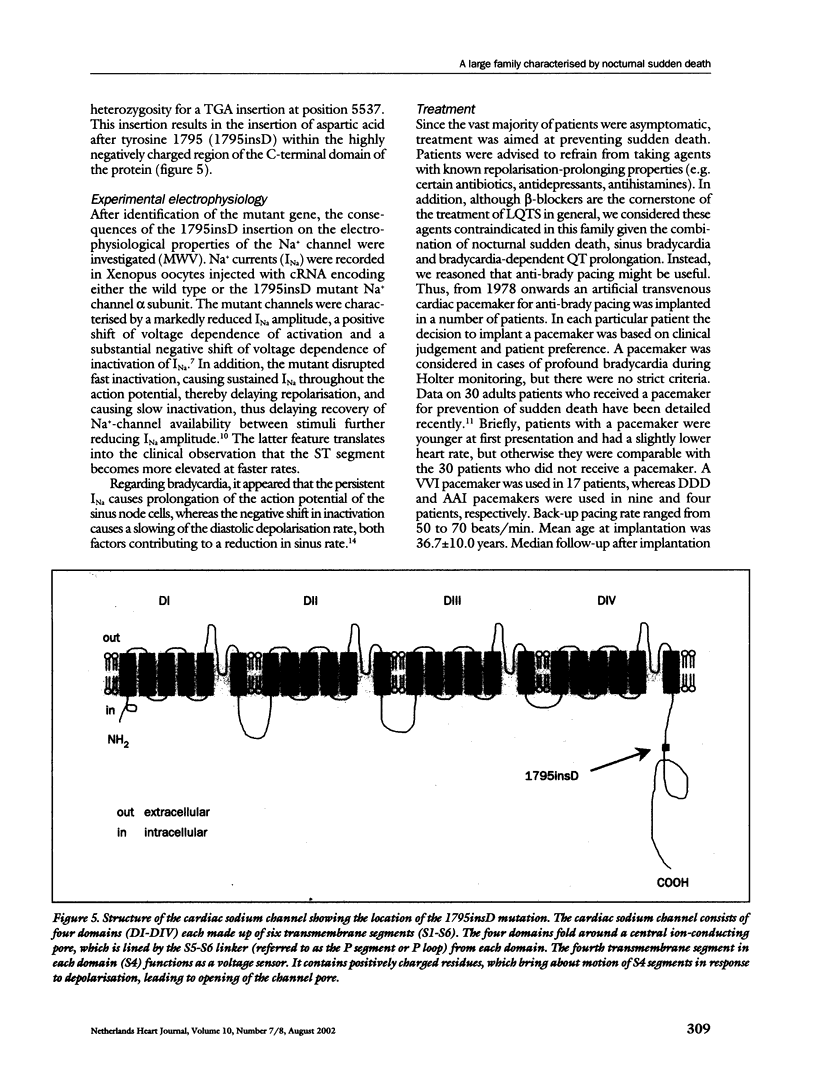
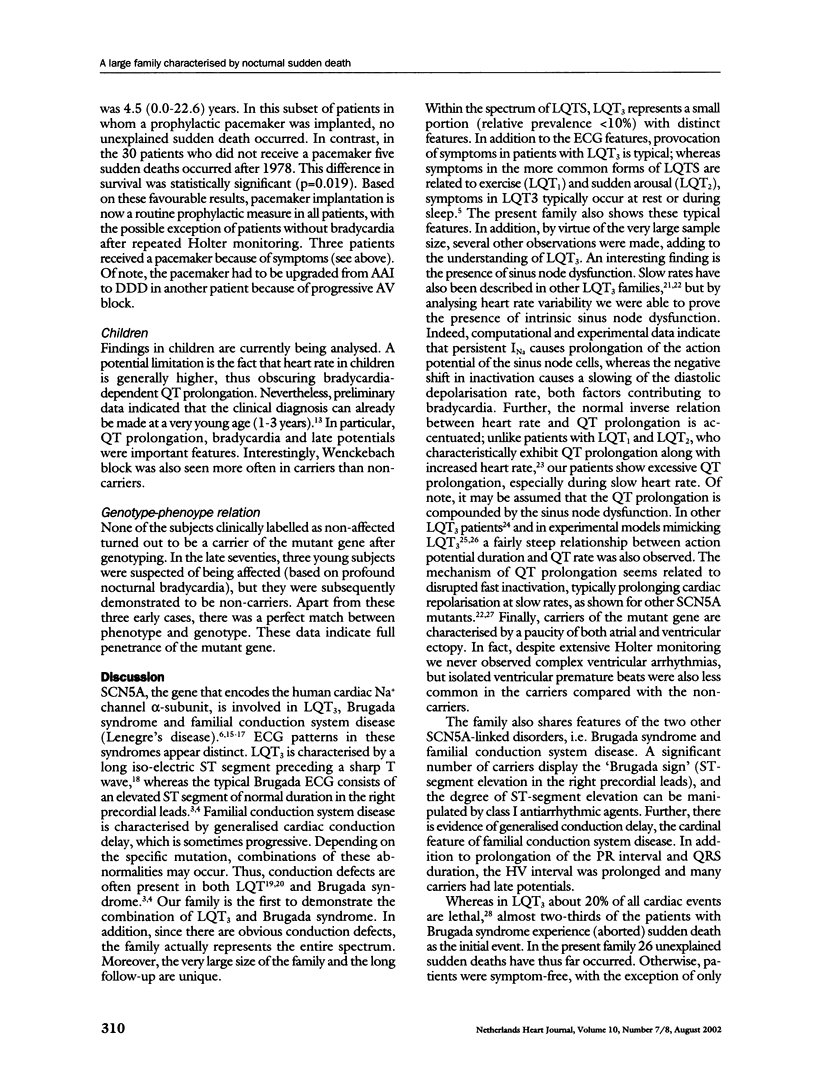
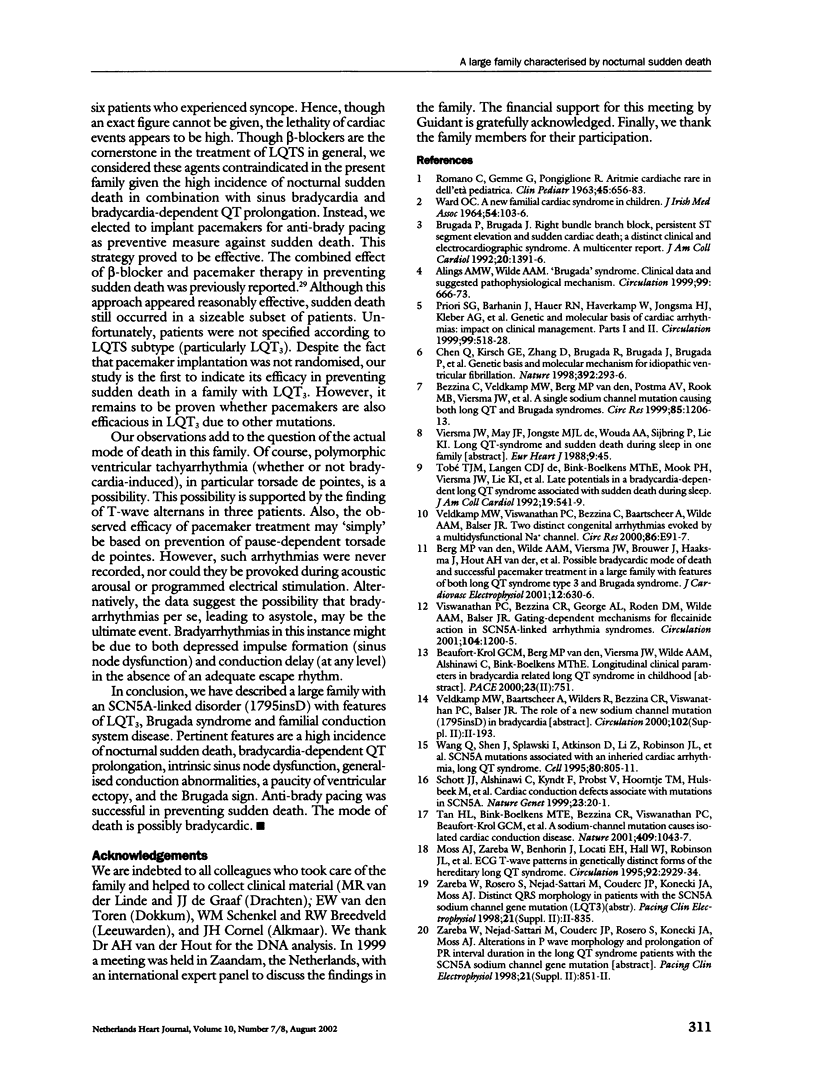
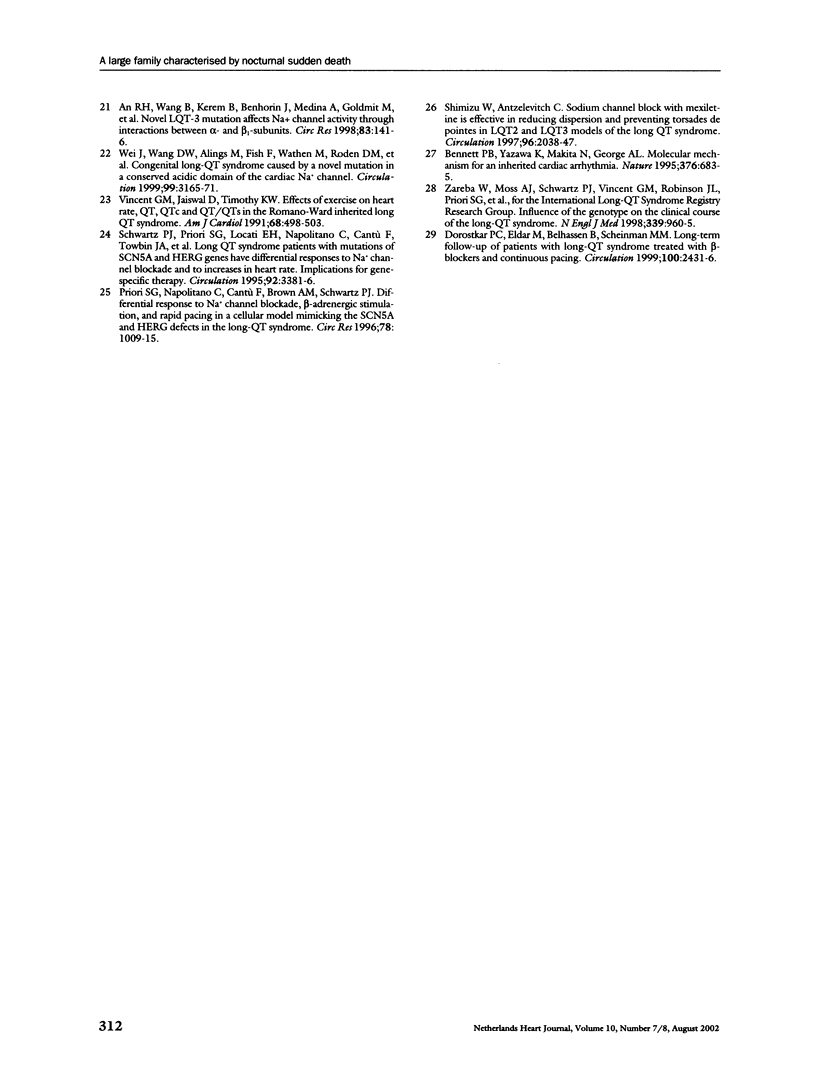
Images in this article
Selected References
These references are in PubMed. This may not be the complete list of references from this article.
- Alings M., Wilde A. "Brugada" syndrome: clinical data and suggested pathophysiological mechanism. Circulation. 1999 Feb 9;99(5):666–673. doi: 10.1161/01.cir.99.5.666. [DOI] [PubMed] [Google Scholar]
- An R. H., Wang X. L., Kerem B., Benhorin J., Medina A., Goldmit M., Kass R. S. Novel LQT-3 mutation affects Na+ channel activity through interactions between alpha- and beta1-subunits. Circ Res. 1998 Jul 27;83(2):141–146. doi: 10.1161/01.res.83.2.141. [DOI] [PubMed] [Google Scholar]
- Bennett P. B., Yazawa K., Makita N., George A. L., Jr Molecular mechanism for an inherited cardiac arrhythmia. Nature. 1995 Aug 24;376(6542):683–685. doi: 10.1038/376683a0. [DOI] [PubMed] [Google Scholar]
- Bezzina C., Veldkamp M. W., van Den Berg M. P., Postma A. V., Rook M. B., Viersma J. W., van Langen I. M., Tan-Sindhunata G., Bink-Boelkens M. T., van Der Hout A. H. A single Na(+) channel mutation causing both long-QT and Brugada syndromes. Circ Res. 1999 Dec 3;85(12):1206–1213. doi: 10.1161/01.res.85.12.1206. [DOI] [PubMed] [Google Scholar]
- Brugada P., Brugada J. Right bundle branch block, persistent ST segment elevation and sudden cardiac death: a distinct clinical and electrocardiographic syndrome. A multicenter report. J Am Coll Cardiol. 1992 Nov 15;20(6):1391–1396. doi: 10.1016/0735-1097(92)90253-j. [DOI] [PubMed] [Google Scholar]
- Chen Q., Kirsch G. E., Zhang D., Brugada R., Brugada J., Brugada P., Potenza D., Moya A., Borggrefe M., Breithardt G. Genetic basis and molecular mechanism for idiopathic ventricular fibrillation. Nature. 1998 Mar 19;392(6673):293–296. doi: 10.1038/32675. [DOI] [PubMed] [Google Scholar]
- Dorostkar P. C., Eldar M., Belhassen B., Scheinman M. M. Long-term follow-up of patients with long-QT syndrome treated with beta-blockers and continuous pacing. Circulation. 1999 Dec 14;100(24):2431–2436. doi: 10.1161/01.cir.100.24.2431. [DOI] [PubMed] [Google Scholar]
- Go A. S., Hylek E. M., Phillips K. A., Borowsky L. H., Henault L. E., Chang Y., Selby J. V., Singer D. E. Implications of stroke risk criteria on the anticoagulation decision in nonvalvular atrial fibrillation: the Anticoagulation and Risk Factors in Atrial Fibrillation (ATRIA) study. Circulation. 2000 Jul 4;102(1):11–13. doi: 10.1161/01.cir.102.1.11. [DOI] [PubMed] [Google Scholar]
- Moss A. J., Zareba W., Benhorin J., Locati E. H., Hall W. J., Robinson J. L., Schwartz P. J., Towbin J. A., Vincent G. M., Lehmann M. H. ECG T-wave patterns in genetically distinct forms of the hereditary long QT syndrome. Circulation. 1995 Nov 15;92(10):2929–2934. doi: 10.1161/01.cir.92.10.2929. [DOI] [PubMed] [Google Scholar]
- Priori S. G., Barhanin J., Hauer R. N., Haverkamp W., Jongsma H. J., Kleber A. G., McKenna W. J., Roden D. M., Rudy Y., Schwartz K. Genetic and molecular basis of cardiac arrhythmias: impact on clinical management parts I and II. Circulation. 1999 Feb 2;99(4):518–528. doi: 10.1161/01.cir.99.4.518. [DOI] [PubMed] [Google Scholar]
- Priori S. G., Napolitano C., Cantù F., Brown A. M., Schwartz P. J. Differential response to Na+ channel blockade, beta-adrenergic stimulation, and rapid pacing in a cellular model mimicking the SCN5A and HERG defects present in the long-QT syndrome. Circ Res. 1996 Jun;78(6):1009–1015. doi: 10.1161/01.res.78.6.1009. [DOI] [PubMed] [Google Scholar]
- ROMANO C., GEMME G., PONGIGLIONE R. ARITMIE CARDIACHE RARE DELL'ETA' PEDIATRICA. II. ACCESSI SINCOPALI PER FIBRILLAZIONE VENTRICOLARE PAROSSISTICA. (PRESENTAZIONE DEL PRIMO CASO DELLA LETTERATURA PEDIATRICA ITALIANA) Clin Pediatr (Bologna) 1963 Sep;45:656–683. [PubMed] [Google Scholar]
- Schott J. J., Alshinawi C., Kyndt F., Probst V., Hoorntje T. M., Hulsbeek M., Wilde A. A., Escande D., Mannens M. M., Le Marec H. Cardiac conduction defects associate with mutations in SCN5A. Nat Genet. 1999 Sep;23(1):20–21. doi: 10.1038/12618. [DOI] [PubMed] [Google Scholar]
- Schwartz P. J., Priori S. G., Locati E. H., Napolitano C., Cantù F., Towbin J. A., Keating M. T., Hammoude H., Brown A. M., Chen L. S. Long QT syndrome patients with mutations of the SCN5A and HERG genes have differential responses to Na+ channel blockade and to increases in heart rate. Implications for gene-specific therapy. Circulation. 1995 Dec 15;92(12):3381–3386. doi: 10.1161/01.cir.92.12.3381. [DOI] [PubMed] [Google Scholar]
- Shimizu W., Antzelevitch C. Sodium channel block with mexiletine is effective in reducing dispersion of repolarization and preventing torsade des pointes in LQT2 and LQT3 models of the long-QT syndrome. Circulation. 1997 Sep 16;96(6):2038–2047. doi: 10.1161/01.cir.96.6.2038. [DOI] [PubMed] [Google Scholar]
- Tan H. L., Bink-Boelkens M. T., Bezzina C. R., Viswanathan P. C., Beaufort-Krol G. C., van Tintelen P. J., van den Berg M. P., Wilde A. A., Balser J. R. A sodium-channel mutation causes isolated cardiac conduction disease. Nature. 2001 Feb 22;409(6823):1043–1047. doi: 10.1038/35059090. [DOI] [PubMed] [Google Scholar]
- Tobé T. J., de Langen C. D., Bink-Boelkens M. T., Mook P. H., Viersma J. W., Lie K. I., Wesseling H. Late potentials in a bradycardia-dependent long QT syndrome associated with sudden death during sleep. J Am Coll Cardiol. 1992 Mar 1;19(3):541–549. doi: 10.1016/s0735-1097(10)80269-4. [DOI] [PubMed] [Google Scholar]
- Vincent G. M., Jaiswal D., Timothy K. W. Effects of exercise on heart rate, QT, QTc and QT/QS2 in the Romano-Ward inherited long QT syndrome. Am J Cardiol. 1991 Aug 15;68(5):498–503. doi: 10.1016/0002-9149(91)90785-j. [DOI] [PubMed] [Google Scholar]
- Viswanathan P. C., Bezzina C. R., George A. L., Jr, Roden D. M., Wilde A. A., Balser J. R. Gating-dependent mechanisms for flecainide action in SCN5A-linked arrhythmia syndromes. Circulation. 2001 Sep 4;104(10):1200–1205. doi: 10.1161/hc3501.093797. [DOI] [PubMed] [Google Scholar]
- Wang Q., Shen J., Splawski I., Atkinson D., Li Z., Robinson J. L., Moss A. J., Towbin J. A., Keating M. T. SCN5A mutations associated with an inherited cardiac arrhythmia, long QT syndrome. Cell. 1995 Mar 10;80(5):805–811. doi: 10.1016/0092-8674(95)90359-3. [DOI] [PubMed] [Google Scholar]
- Wei J., Wang D. W., Alings M., Fish F., Wathen M., Roden D. M., George A. L., Jr Congenital long-QT syndrome caused by a novel mutation in a conserved acidic domain of the cardiac Na+ channel. Circulation. 1999 Jun 22;99(24):3165–3171. doi: 10.1161/01.cir.99.24.3165. [DOI] [PubMed] [Google Scholar]
- Zareba W., Moss A. J., Schwartz P. J., Vincent G. M., Robinson J. L., Priori S. G., Benhorin J., Locati E. H., Towbin J. A., Keating M. T. Influence of genotype on the clinical course of the long-QT syndrome. International Long-QT Syndrome Registry Research Group. N Engl J Med. 1998 Oct 1;339(14):960–965. doi: 10.1056/NEJM199810013391404. [DOI] [PubMed] [Google Scholar]
- van den Berg M. P., Wilde A. A., Viersma TJW, Brouwer J., Haaksma J., van der Hout A. H., Stolte-Dijkstra I., Bezzina TCR, Van Langen I. M., Beaufort-Krol G. C. Possible bradycardic mode of death and successful pacemaker treatment in a large family with features of long QT syndrome type 3 and Brugada syndrome. J Cardiovasc Electrophysiol. 2001 Jun;12(6):630–636. doi: 10.1046/j.1540-8167.2001.00630.x. [DOI] [PubMed] [Google Scholar]



